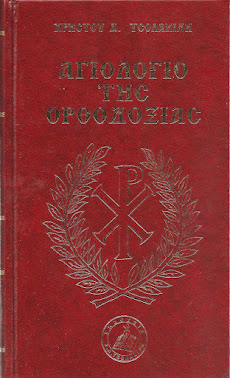Αναζήτηση αυτού του ιστολογίου
Παρασκευή 21 Μαρτίου 2014
St. Anthony’s Greek Orthodox Monastery: Walking a prayerful path.
Visitors to the sanctuary of the main chapel at St.
Anthony’s Greek Orthodox Monastery, located south of Florence, enjoy the
carvings, paintings and icons of the order.
By BILL COATES, Casa Grande Dispatch FLORENCE, The
main entrance is marked by a high arch. It separates the desert from a world
shaded by date palms and olive trees. It’s a world of quiet reflection and
ornately decorated churches and chapels.
It’s also a world of deep piety for the 48 monks who
make St. Anthony’s Greek Orthodox Monastery their home. They spend their days
and nights in prayer, church and work.
They also welcome visitors.
I visited the 106-acre monastery earlier this month,
along with Dispatch photographer Steven King. St. Anthony’s is about 12 miles
southeast of Florence, off Arizona 79. The first hint you’re near it is a large
white church on a hill. It’s part of the monastery but closed to visitors.
The main entrance is a gate beneath the arch. Inside
is a plaza with a shaded ramada. There is no charge to visit the monastery, but
there are rules. Long-sleeve shirts and blouses are required for men and women.
Women have to wear headscarves, too.
If you don’t have a headscarf or long-sleeved shirt,
you can borrow one. Boxes of them are set out on a bench.
Monks dressed in black cassocks greet visitors with
water and a sweet snack.
Father Seraphim greeted me at the bookstore. He has
been living at the monastery for 11 years. Before that, he was a student. He
hesitated to say much more about himself
but gave me the rundown on a day in
the life of a monk.
“We get up at 10 o’clock every evening,” Father
Seraphim said.
The monks then devote the next three hours to personal
prayer in their rooms. From 1 to 4 a.m., they attend church. That’s followed by
a light breakfast and three hours of rest.
“Then we start our workday with different jobs,”
Father Seraphim said. Lunch is at 1:30 followed by a bit more work, followed by
three hours of vespers, or evening prayer. Then dinner. Around 6, it’s bedtime
— getting up at 10 again for personal prayer.
Being a monk is no free lunch.
Visiting hours are tied to the monks’ daily schedule.
The gates open at 10:30 a.m, and no one is admitted after 2:30 p.m.
Visitor’s question
As I spoke to Father Seraphim, a visitor approached
him and asked if the monks sang.
“We sing to the Lord a lot,” she volunteered, adding
she was a Protestant.
Father Seraphim said the monks do chant.
After a few more visitors arrived, Father Seraphim
gave a short presentation. It’s a self-guided tour, and he largely went over
the ground rules. Namely, don’t enter doors marked “don’t enter.” Certain areas
inside the churches are off limits as well, including altars hidden behind
curtains.
It’s OK to take pictures of churches and the grounds,
but not the monks.
I don’t recall if Father Seraphim mentioned how the
monastery got started. It’s on the monastery’s website, though. St. Anthony’s
was established by the Elder Ephraim and six monks in 1995. They modeled it
after monasteries on Mount Athos, a sacred mountain for the Greek Orthodox
Church.
The Arizona monastery is dedicated to St. Anthony the
Great, the third century father of monasticism. The main church at St.
Anthony’s is dedicated to him as well, along with St. Nectarios.
With a map in hand, I headed for the church. Strolling
the grounds is relaxing and peaceful. The paths are lined with trees, palms and
shrubs. It’s almost like a walk in the woods — mostly quiet, except for bird
song.
Along the way, monks silently went about their work.
Sweeping and caring for the grounds.
Father Euphrosynos was among them. He cares for the
date palms, among other things. His given name was Bill, but as a monk he
acquired the name of a ninth century saint. All the monks take on saintly
names.
Father Euphrosynos, 61, entered the monastery in 1997.
Before that, as Bill, he drove taxis and limousines. He hitchhiked around
Alaska.
The monastic life isn’t to be taken lightly.
“It comes from God,” he said. “You’re looking for a
higher level of spirituality.”
And while he works, he prays. All the monks pray throughout
the day, even in work, he said.
So he went back to work and prayer.
St. Anthony’s Church is a large stone structure,
painted a rich earth-red. The entrance leads to the narthex, a smaller room off
the main sanctuary. Non-orthodox worshippers, if they attend a service, are
asked to stand in the narthex. Afternoon services are 3:30 daily.
Stand to worship
The central worship area has a large open space and a
high ceiling, punctuated by a dome with an ornate chandelier. Large icons of
the saints are in panels trimmed in gold paint. There are no pews. Worshippers
stand. High-backed wooden chairs line the walls, however. They offer tired
worshippers a place to sit. Visitors are cautioned against sitting in the most
ornate chair. It’s reserved for the visiting bishop.
Most of the icons and furnishings at St. Anthony’s
were brought over from Greece, according to a handout. One icon was painted
just for the monastery, though — Panagia Arizonitissa, or Virgin of Arizona.
Following the map, I found my way to St. Nicholas’
Chapel. It’s a building of arches and stonework that, in the words of the
handout, is an “exquisite example of Byzantine architecture that will
‘transport’ you instantly to an ‘out of this world’ realm.”
I was impressed, if not transported.
The walk from St. Nicholas to the next chapel, St.
George, skirts groves of citrus and olive trees.
The monks press and bottle their own olive oil,
available in the bookstore. So is baklava and other Greek pastries, made by the
monks themselves.
At St. George, I didn’t see a lot of doors marked
“don’t enter.” I wasn’t sure how to get in. I asked a passerby, who pointed me
to the right door.
He was an overnight guest, a pilgrim. Pilgrims are
confirmed members or people looking into confirmation. Pilgrims are expected to
attend all services, even early morning worship.
St. George’s Chapel has an intricately hand-carved
partition known as an iconostasis, decorated with icons. St. Demetrios Chapel
is a brick building with a Russian touch. It has an onion dome and a pitched
high ceiling of wood.
Nearby is the Fountain of the Cross.
The cross is larger than life and made of stone. It’s
a traditional Greek Orthodox cross with three crossbars, a design explained in
the handout. The bottom bar was for Christ’s feet. But it’s slanted — upward
for the thief crucified on Christ’s right. He went to heaven. And slanted down
for the other thief, the bad thief. It’s no mystery which way he went.
St. Seraphim’s is the last chapel on the walk. It’s a
small and simple open-air place of prayer.
The bookstore is good for a last visit on the way out.
It’s filled with icons, religious books and, of course, the treats. Outside the
gateway, beyond the parking lot, is a cemetery. I took a brief stroll through
it. The names on the large white crosses are lettered in Greek.
The graves are set apart in sections.
There was a section for monks and a section for nuns.
Orthodox lay members had their own sections. One for men and one for women.
It’s a separation observed in church services as well,
a monk told me.
I went back to my car and was soon rolling through the
Sonoran desert. I had to admit: After two hours in a monastic garden, I had a
greater appreciation of the natural world.
Εγγραφή σε:
Σχόλια ανάρτησης (Atom)











Δεν υπάρχουν σχόλια:
Δημοσίευση σχολίου